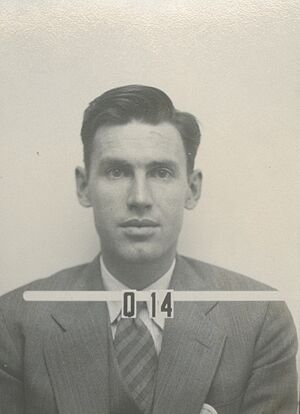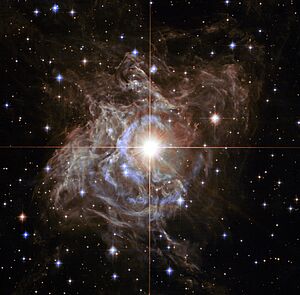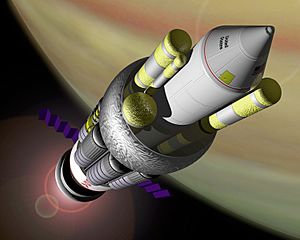Robert F. Christy facts for kids
Quick facts for kids
Robert Frederick Christy
|
|
|---|---|

Robert F. Christy c. 1959
|
|
| Acting President of the California Institute of Technology | |
| In office 1977–1978 |
|
| Preceded by | Harold Brown |
| Succeeded by | Marvin Leonard Goldberger |
| Personal details | |
| Born |
Robert Frederick Cohen
May 14, 1916 Vancouver, British Columbia, Canada |
| Died | October 3, 2012 (aged 96) Pasadena, California, U.S. |
| Citizenship | Canadian American |
| Alma mater | |
| Known for | Christy pits |
| Awards | Eddington Medal (1967) Bronze Academic Medal of the Governor-General of Canada (1932) |
| Scientific career | |
| Fields | Physics |
| Institutions |
|
| Thesis | Cosmic-ray burst production and the spin of the mesotron (1941) |
| Doctoral advisor | Robert Oppenheimer |
| Signature | |
 |
|
Robert Frederick Christy (May 14, 1916 – October 3, 2012) was a brilliant Canadian-American theoretical physicist. He later became an astrophysicist, studying stars and space. He was one of the last people alive who worked on the Manhattan Project during World War II. This was a top-secret project to build the first atomic bombs. Later in his career, he was the acting president of California Institute of Technology (Caltech) for a short time.
Christy studied physics at the University of British Columbia (UBC) in the 1930s. He then went to the University of California, Berkeley, where he became a student of Robert Oppenheimer. Oppenheimer was a leading theoretical physicist in the United States. Christy earned his doctorate degree in 1941. After that, he joined the physics department at Illinois Institute of Technology.
In 1942, he joined the Manhattan Project at the University of Chicago. There, Enrico Fermi asked him to help build the first nuclear reactor. In 1943, Oppenheimer started the Los Alamos Laboratory for the Manhattan Project. Christy was one of the first scientists to join the Theory Group there. Christy is famous for suggesting a simpler way to build a nuclear weapon. He proposed using a solid piece of plutonium that could be squeezed very quickly to create an explosion. This idea was a big step forward. Because of his idea, this solid-core plutonium design is often called the "Christy pit".
After the war, Christy joined the faculty at Caltech in 1946. He stayed at Caltech for his whole career. He served as the head of the physics department, a provost (a senior academic officer), and acting president. In the 1960s, Christy started studying astrophysics. He created some of the first computer models to understand how stars change their brightness. For this important work, he received the Eddington Medal in 1967.
Contents
Early Life and Education
Robert Frederick Cohen was born on May 14, 1916, in Vancouver, British Columbia, Canada. His father, Moise Jacques Cohen, was an electrical engineer. His mother, Hattie Alberta Mackay, was a school teacher. In 1918, his family changed their last name to Christy.
Christy went to Magee Secondary School. He graduated in 1932 with the highest test score in British Columbia. He won the Governor General's Academic Medal. This award also gave him free tuition to attend the University of British Columbia (UBC). This was very helpful because his family did not have much money. At UBC, he earned his first degree in mathematics and physics in 1935. He then got his master's degree in 1937.
A friend from UBC, George Volkoff, went to the University of California, Berkeley for graduate school. He was accepted by Robert Oppenheimer, a very important physicist. This inspired Christy to apply to Berkeley too. He was accepted and received a scholarship. For his PhD, Oppenheimer asked him to study mesotrons. These are tiny particles found in cosmic rays, which are now called muons. Christy did detailed calculations about these particles. He published two papers on them, which became the basis for his 1941 PhD thesis.
Working on the Manhattan Project

In 1941, Christy joined the physics department at Illinois Institute of Technology (IIT). In May 1941, he married Dagmar von Lieven. They had two sons, Thomas and Peter. In 1942, he moved to the University of Chicago to work on the Manhattan Project.
Enrico Fermi asked Christy to join his team. They were building the first nuclear reactor, which Fermi called a "pile." Christy was there when the reactor, named Chicago Pile-1, started working on December 2, 1942. This was a huge moment in science.
In early 1943, Christy moved to Los Alamos Laboratory in New Mexico. This was where the atomic bombs were being designed. He became an American citizen around this time. Christy helped a group that was building a small reactor called the Water Boiler. This reactor was used to test calculations for building atomic bombs. Christy's calculations for the amount of uranium-235 needed were very accurate. This made the scientists at Los Alamos trust the calculations from his team even more.
Scientists later found a problem with the plutonium they were using for the bombs. This meant they needed a new design called an implosion-type nuclear weapon. Christy suggested using a solid core of plutonium. This design was simpler and more reliable. It became known as the "Christy pit." The first atomic bomb, called The Gadget, used in the Trinity nuclear test, and the "Fat Man" bomb dropped on Nagasaki, both used Christy pits.
Later in his life, Robert Christy gave many interviews. He talked about his important role in the Manhattan Project and his other interests.
Life After the War
After World War II ended, Christy became an assistant professor at the University of Chicago. In 1946, he moved to Pasadena, California, to join the faculty at California Institute of Technology (Caltech). He stayed at Caltech for the rest of his career. He became a full professor and took on many leadership roles.
In 1956, Christy and other scientists from Caltech spoke out. They asked for a ban on nuclear weapons tests in the atmosphere. The 1963 Partial Nuclear Test Ban Treaty helped stop these tests. Christy also worked on Project Orion. This was a very unusual project to design a spacecraft that would be pushed by atomic bombs.

In 1960, Christy began studying Cepheid variables and RR Lyrae variables. These are types of bright stars that change their brightness over time. Scientists didn't know why this happened. Christy used his knowledge of how things explode and compress, which he learned during the war, to explain this mystery. He showed how these stars pulsate. For this work, he received the Eddington Medal in 1967.
In 1970, Christy became the vice president and Provost of Caltech. He helped Caltech expand its programs in subjects like humanities and economics. This allowed students to get a broader education. Also, the first women were admitted as undergraduate students to Caltech in the fall of 1970.
Christy briefly served as acting President of Caltech in 1977. This happened when the previous president, Harold Brown, left to become the Secretary of Defense. Christy went back to teaching after a new president, Marvin L. Goldberger, took over in 1978. He became a special professor of theoretical physics in 1983. He retired in 1986.
Robert Christy passed away on October 3, 2012. He is remembered for his important work in physics, his contributions to the Manhattan Project, and his studies of stars.
Images for kids



